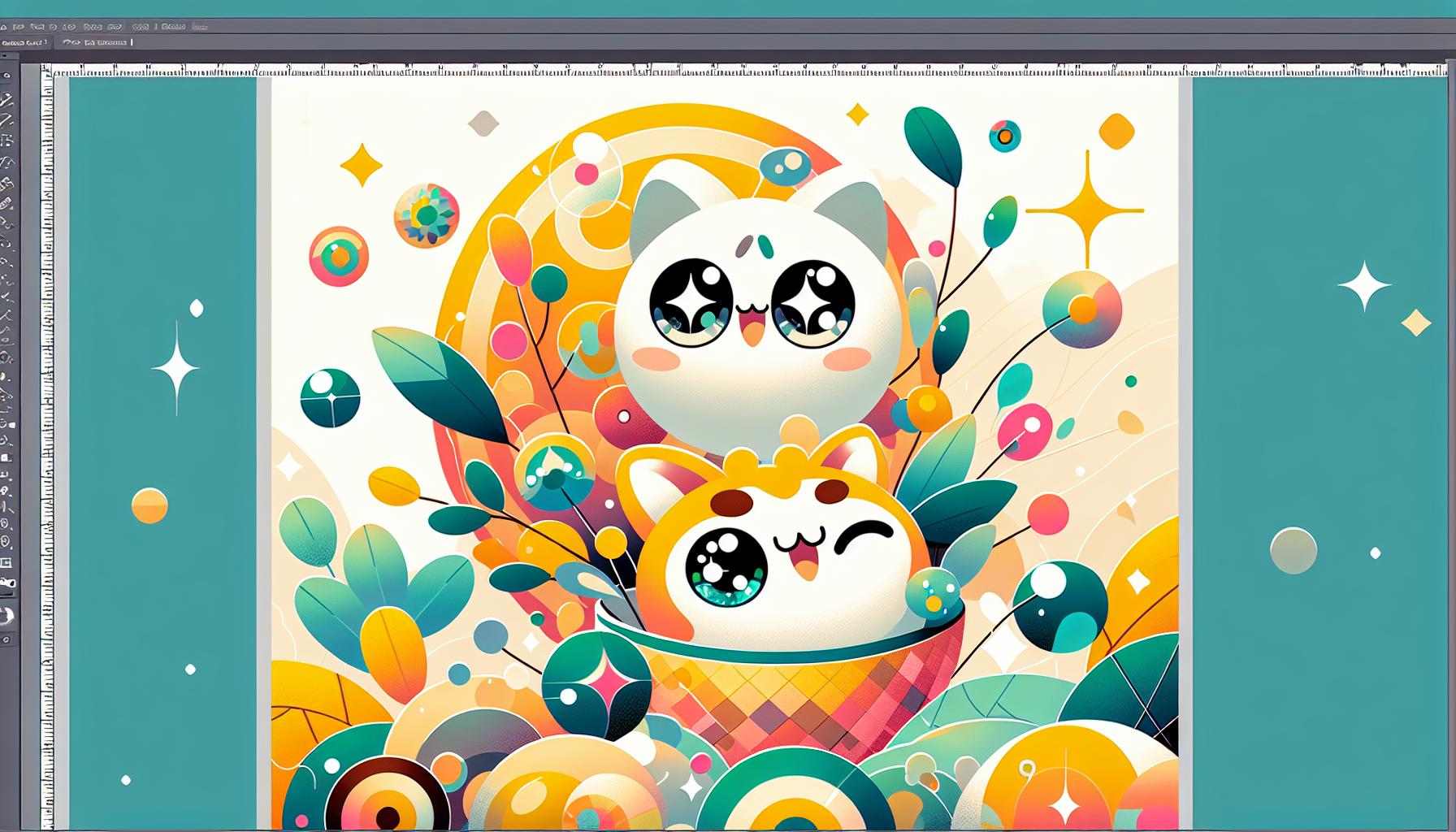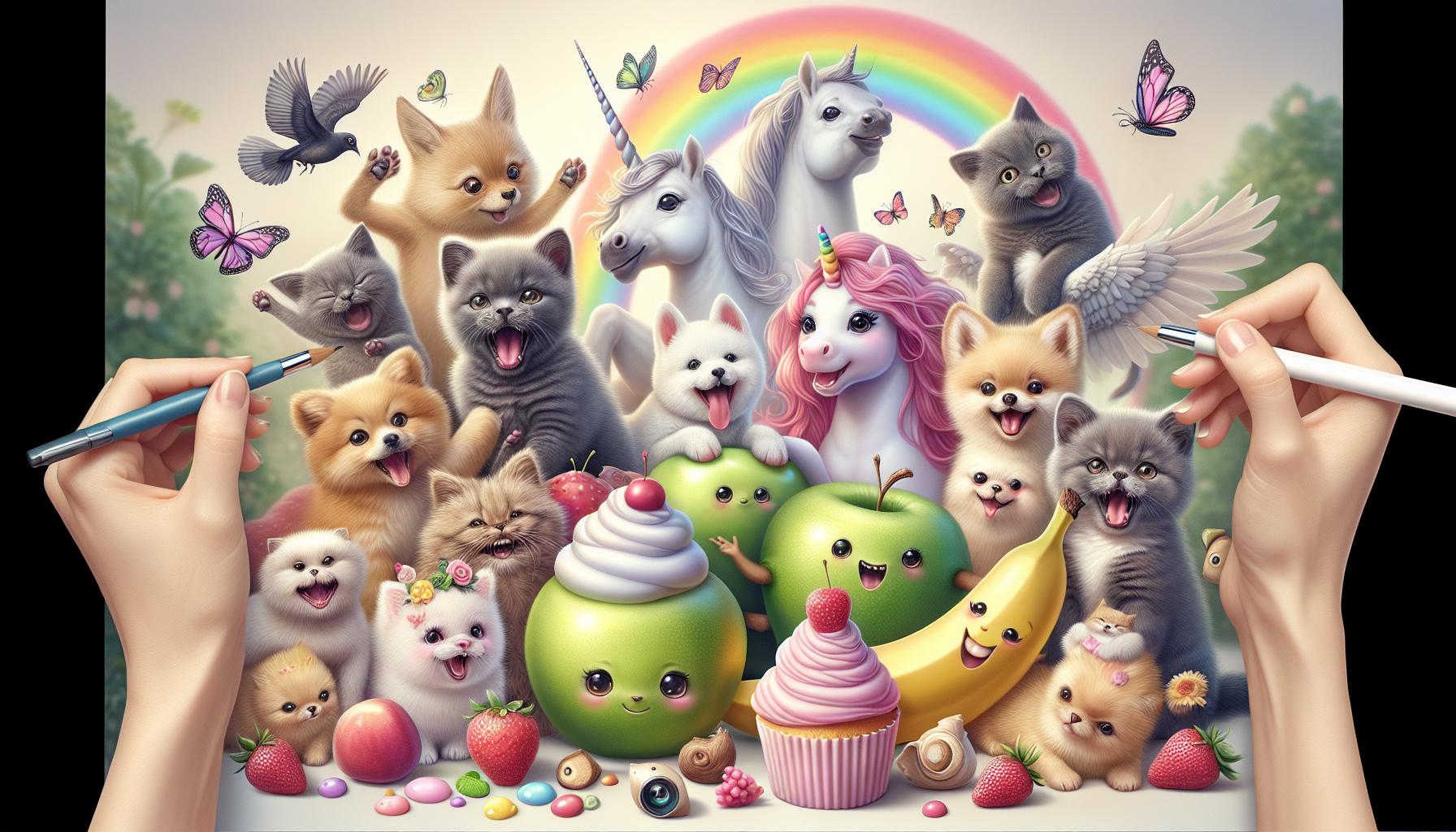Transforming simple lines and shapes into adorable works of art has become a delightful trend that’s capturing hearts worldwide. From kawaii-style doodles to minimalist cartoon characters, cute drawings offer a perfect escape into a world of whimsy and charm.
Creating cute drawings isn’t just about artistic talent – it’s about understanding the basic elements that make something universally appealing. Those big round eyes, tiny smiles, and soft curves can turn even the most ordinary objects into lovable characters that spark joy and creativity in both artists and viewers alike. Whether you’re a seasoned illustrator or just starting your artistic journey, mastering the art of cute drawings opens up endless possibilities for self-expression and spreading happiness through art.
Cute:dyw0ynovgh0= Drawings
Cute drawings embody simplified artistic representations that feature exaggerated proportions designed to evoke feelings of warmth and endearment. These illustrations incorporate rounded shapes, soft lines and oversized facial features to create an instant emotional connection with viewers.
Common characteristics of cute drawings include:
- Large eyes with reflective spots
- Button-like noses placed high on the face
- Small mouths drawn in simple curves
- Minimized or absent facial details
- Rounded body shapes without sharp angles
- Pastel color palettes
The artistic style breaks down into several recognizable categories:
- Chibi characters with disproportionately large heads
- Kawaii-inspired food items with smiling faces
- Simple animal doodles with emphasized expressions
- Baby versions of everyday objects
- Miniaturized mascot designs
Artists employ specific techniques to achieve cuteness in their work:
- Enlarging key features like eyes up to 50% of face size
- Positioning facial elements in the center 30% of the head
- Rounding edges to eliminate sharp corners
- Adding blush marks as small circles or ovals
- Creating symmetrical compositions
Modern cute drawings blend elements from multiple sources:
- Japanese manga influences
- Western cartoon styling
- Contemporary minimalist design
- Digital art techniques
- Traditional illustration methods
- Social media stickers
- Greeting card designs
- Brand mascots
- Children’s book illustrations
- Digital emoticons
Essential Elements of Cute Drawing Style

Creating adorable artwork requires mastering specific design elements that consistently evoke feelings of warmth and delight. These fundamental components form the foundation of cute character design and illustration.
Simple Rounded Shapes
Rounded shapes create the basic structure of cute drawings through soft curves and circular forms. Basic geometric elements like circles ovals circles become heads bodies limbs in cute characters. Artists incorporate gentle curves to soften edges eliminating sharp angles or harsh lines. The roundness appears in multiple elements: puffy cheeks rounded ears circular paws bubble-like body shapes. This simplification technique transforms complex forms into approachable friendly figures that appeal to viewers emotional responses.
Large Eyes and Small Features
Eyes dominate cute character designs taking up 30-40% of facial space with simplified shapes like circles or ovals. Small noses mouths appear as basic dots curves or tiny triangles creating a balanced facial composition. Artists position these features in the lower portion of the face leaving ample space for the enlarged eyes. Reflective spots called catchlights add sparkle depth to the eyes enhancing their emotional impact. The deliberate size contrast between eyes other facial elements creates an infant-like appearance that triggers protective instincts in viewers.
Basic Techniques for Creating Cute Art

Creating cute art relies on mastering fundamental techniques that transform simple shapes into adorable characters. These core skills establish the foundation for developing a distinctive cute art style.
Line Work and Proportions
Clean line work forms the basis of cute drawings, featuring smooth curves and rounded edges. Artists start with basic geometric shapes like circles and ovals to establish the character’s structure. The head typically measures 1/3 to 1/2 of the total body height, creating a compact chibi-like appearance. Eyes occupy 1/3 of the face width, while the nose and mouth remain small at 1/4 the size of the eyes. Limbs maintain shorter proportions at 2-3 head lengths, enhancing the cute factor through simplified forms. Consistency in line weight varies between 2-4 pixels for digital art or 0.3-0.8mm for traditional mediums.
Adding Character Expression
Expressions in cute art combine exaggerated features with minimalist details to convey emotion. The eyes communicate 70% of the character’s mood through variations in shape, size and position. Large sparkles or highlights in the eyes create a sense of life and energy. Small curved lines form simple yet effective mouth shapes – upward curves for joy, gentle downward curves for sadness, tiny circles for surprise. Eyebrows consist of thin lines positioned high on the forehead to maximize the forehead space. Blush marks appear as small circles or curved lines beneath the eyes to enhance cuteness.
Popular Subjects for Cute Drawings

Cute drawings encompass a diverse range of subjects that appeal to artists worldwide. These subjects combine simple shapes with endearing features to create instantly recognizable characters.
Animals and Creatures
Animals dominate the cute drawing landscape with cats ranking as the most frequently drawn subject. Artists transform common pets like dogs puppies kittens rabbits into adorable characters by enlarging their eyes exaggerating their paws adding rosy cheeks. Fantasy creatures including unicorns dragons mermaids feature rounded edges soft expressions baby-like proportions. Popular woodland creatures like foxes bears raccoons adapt well to the cute style through emphasized fluff simplified shapes characteristic markings. Sea creatures such as whales dolphins penguins translate effectively into cute drawings by focusing on their streamlined forms playful expressions.
Food and Objects
Everyday items transform into charming characters through anthropomorphization. Desserts lead this category with cupcakes ice cream donuts sporting tiny smiles rosy cheeks. Fresh fruits vegetables become appealing characters – strawberries avocados carrots feature expressive faces tiny limbs. Common objects like coffee cups books pencils take on personalities through the addition of simple facial features kawaii-style expressions. Artists regularly combine food items to create unique character combinations such as sushi rolls with cat ears pizza slices with sleepy eyes. Household items including teapots pillows plants receive cute makeovers through rounded corners gentle curves minimalist faces.
Digital vs Traditional Cute Drawing Methods
Digital art tools transform cute drawing creation through precision controls and unlimited color options. Applications like Procreate iPad introduce features such as stabilized line work perfect for smooth curves in kawaii characters. Traditional mediums including colored pencils markers provide tactile feedback that enhances artistic expression.
Digital platforms offer:
- Layer management for complex compositions
- Infinite undo capabilities
- Preset brush collections for various textures
- Color palette organization tools
- Quick resizing adjustability
Traditional methods provide:
- Direct hand to paper connection
- No battery or device dependencies
- Immediate portability
- Unique texture variations
- Original physical artwork
Here’s how the methods compare in key aspects:
| Aspect | Digital | Traditional |
|---|---|---|
| Cost | $400-1000 initial investment | $20-50 starter kit |
| Learning Curve | 2-3 months | 1-2 weeks |
| Color Options | Unlimited | Limited to supplies |
| Storage Space | Virtual | Physical |
| Editing Flexibility | High | Minimal |
Artists combine both approaches to maximize creative potential. Digital tools excel at producing clean lines symmetrical shapes required for professional cute illustrations. Traditional sketching builds fundamental skills through direct medium interaction. Hybrid workflows start with traditional rough sketches then transition to digital platforms for final rendering perfection.
Each method serves specific purposes in cute art creation. Digital platforms streamline production for commercial projects social media content merchandise designs. Traditional techniques maintain authenticity in original artwork gallery pieces commissioned illustrations.
Tips for Developing Your Cute Art Style
Creating a consistent cute art style requires mastering fundamental techniques that enhance character appeal. Practice these key approaches to develop a unique artistic voice:
- Study Basic Shapes
- Start compositions with circles spheres circles for heads bodies
- Use rounded rectangles for limbs appendages
- Add soft curves to eliminate sharp angles
- Connect shapes with flowing lines
- Perfect Proportions
- Make heads 1/3 to 1/2 of total body height
- Keep limbs short stubby relative to body size
- Enlarge eyes to cover 1/4 to 1/3 of face area
- Position facial features in lower half of head
- Master Expression Elements
- Draw eyes with large highlights reflections
- Create tiny u-shaped or v-shaped smiles
- Add small oval or triangular noses
- Include simple curved eyebrows for emotion
- Refine Details
- Round all corners edges
- Add small blush marks under eyes
- Include minimal shading gradients
- Use pastel color palettes
- Practice Character Types
- Transform animals into chibi forms
- Convert everyday objects into cute mascots
- Design simplified human characters
- Create original creature designs
Artists strengthen their style by:
- Maintaining consistent proportions across characters
- Developing signature facial feature combinations
- Creating repeatable design elements
- Building a recognizable color palette
- Documenting successful techniques in a style guide
Regular practice focusing on these elements helps artists establish their unique interpretation of cute aesthetics while maintaining professional quality standards.
Art Form
Creating cute drawings has evolved into a beloved art form that bridges cultural boundaries and spreads joy worldwide. Artists who master the fundamental elements of cute art – from oversized eyes to rounded shapes – can develop their unique style while maintaining universal appeal.
Whether working digitally or traditionally the key to success lies in consistent practice and understanding core principles. As this artistic style continues to flourish across social media stickers brand mascots and digital content creators have endless opportunities to share their charming creations with a growing global audience.
The enduring popularity of cute drawings proves that sometimes the simplest artistic expressions can create the strongest emotional connections.

